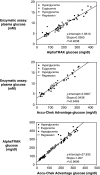Standard operating procedures for describing and performing metabolic tests of glucose homeostasis in mice
- PMID: 20713647
- PMCID: PMC2938392
- DOI: 10.1242/dmm.006239
Standard operating procedures for describing and performing metabolic tests of glucose homeostasis in mice
Abstract
The Mouse Metabolic Phenotyping Center (MMPC) Consortium was established to address the need to characterize the growing number of mouse models of metabolic diseases, particularly diabetes and obesity. A goal of the MMPC Consortium is to propose standard methods for assessing metabolic phenotypes in mice. In this article, we discuss issues pertaining to the design and performance of various tests of glucose metabolism. We also propose guidelines for the description of methods, presentation of data and interpretation of results. The recommendations presented in this article are based on the experience of the MMPC Consortium and other investigators.
Figures




Similar articles
-
NIH experiment in centralized mouse phenotyping: the Vanderbilt experience and recommendations for evaluating glucose homeostasis in the mouse.Am J Physiol Endocrinol Metab. 2009 Oct;297(4):E849-55. doi: 10.1152/ajpendo.90996.2008. Epub 2009 Jul 28. Am J Physiol Endocrinol Metab. 2009. PMID: 19638507 Free PMC article. Review.
-
Approach to assessing determinants of glucose homeostasis in the conscious mouse.Mamm Genome. 2014 Oct;25(9-10):522-38. doi: 10.1007/s00335-014-9533-z. Epub 2014 Jul 30. Mamm Genome. 2014. PMID: 25074441 Free PMC article. Review.
-
Comparative evaluation of simple insulin sensitivity methods based on the oral glucose tolerance test.Diabetologia. 2005 Apr;48(4):748-51. doi: 10.1007/s00125-005-1683-9. Epub 2005 Mar 3. Diabetologia. 2005. PMID: 15744532
-
Glucose tolerance tests for systematic screening of glucose homeostasis in mice.Curr Protoc Mouse Biol. 2015 Mar 2;5(1):65-84. doi: 10.1002/9780470942390.mo140111. Curr Protoc Mouse Biol. 2015. PMID: 25727201
-
[The metabolic characteristics of isolated impaired fasting glucose and fasting hyperglycemia].Zhonghua Nei Ke Za Zhi. 2007 Jul;46(7):555-8. Zhonghua Nei Ke Za Zhi. 2007. PMID: 17959077 Chinese.
Cited by
-
Characterization of liver GSD IX γ2 pathophysiology in a novel Phkg2-/- mouse model.Mol Genet Metab. 2021 Jul;133(3):269-276. doi: 10.1016/j.ymgme.2021.05.008. Epub 2021 May 25. Mol Genet Metab. 2021. PMID: 34083142 Free PMC article.
-
Evaluating Health Span in Preclinical Models of Aging and Disease: Guidelines, Challenges, and Opportunities for Geroscience.J Gerontol A Biol Sci Med Sci. 2016 Nov;71(11):1395-1406. doi: 10.1093/gerona/glw106. Epub 2016 Aug 16. J Gerontol A Biol Sci Med Sci. 2016. PMID: 27535967 Free PMC article.
-
Deletion of Jazf1 gene causes early growth retardation and insulin resistance in mice.Proc Natl Acad Sci U S A. 2022 Dec 6;119(49):e2213628119. doi: 10.1073/pnas.2213628119. Epub 2022 Nov 28. Proc Natl Acad Sci U S A. 2022. PMID: 36442127 Free PMC article.
-
Obesity alters the peripheral circadian clock in the aorta and microcirculation.Microcirculation. 2015 May;22(4):257-66. doi: 10.1111/micc.12192. Microcirculation. 2015. PMID: 25660131 Free PMC article.
-
Evaluation of the appropriateness of using glucometers for measuring the blood glucose levels in mice.Sci Rep. 2016 May 6;6:25465. doi: 10.1038/srep25465. Sci Rep. 2016. PMID: 27151424 Free PMC article.
References
-
- Andrikopoulos S, Blair AR, Deluca N, Fam BC, Proietto J. (2008). Evaluating the glucose tolerance test in mice. Am J Physiol Endocrinol Metab. 295, E1323–E1332 - PubMed
-
- Ayala JE, Bracy DP, McGuinness OP, Wasserman DH. (2006). Considerations in the design of hyperinsulinemic-euglycemic clamps in the conscious mouse. Diabetes 55, 390–397 - PubMed
-
- Ayala JE, Bracy DP, Hansotia T, Flock G, Seino Y, Wasserman DH, Drucker DJ. (2008). Insulin action in the double incretin receptor knockout mouse. Diabetes 57, 288–297 - PubMed
-
- Bailey CJ, Flatt PR. (1980). Insulin and glucagon during pentobarbitone anaesthesia. Diabetes Metab. 6, 91–95 - PubMed
-
- Bailey CJ, Flatt PR. (1982). Hormonal control of glucose homeostasis during development and ageing in mice. Metabolism. 31, 238–246 - PubMed
Publication types
MeSH terms
Substances
Grants and funding
LinkOut - more resources
Full Text Sources
Other Literature Sources

